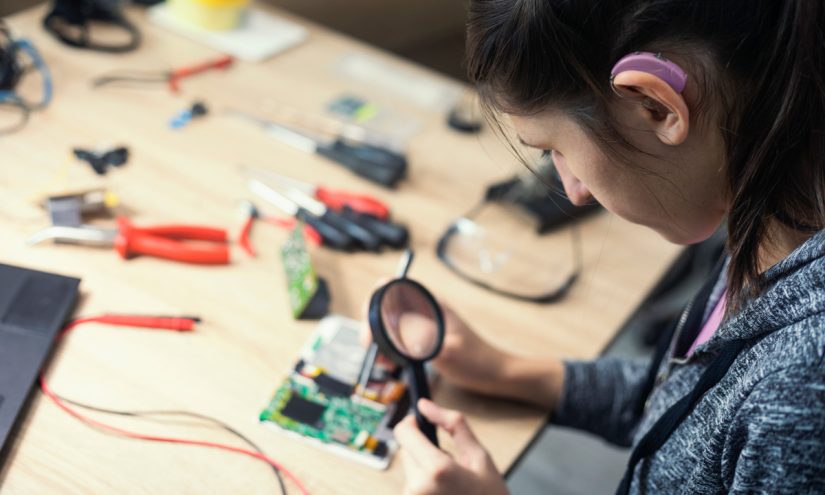
Ed Tech Can Unlock STEM Potential of Students With Disabilities — If It’s Funded – The 74
Table Of Content
Get stories like this delivered straight to your inbox. Sign up for The 74 Newsletter
Thirty-five years after the passage of the Americans with Disabilities Act, students with disabilities still underperform their peers and face ongoing barriers in education and employment. The most recent confirmation came Sept. 9, when the National Assessment of Educational Progress released 2024 science scores for eighth graders and math scores for 12th graders. Three-quarters of students with disabilities scored below NAEP basic, the lowest-performing subgroup.
An estimated 15% of Americans live with a disability. Yet fewer than 10% of such students pursue careers in STEM, even though their interest in science, technology, engineering and math matches that of their peers. That’s a missed opportunity — not just for them, but for American businesses facing a growing talent shortage.
People with disabilities often bring unique skills to STEM, such as advanced digital literacy gained by using assistive technologies and innovative problem-solving abilities resulting from neurodiversity. Virgin founder Richard Branson, for example, credits dyslexia for influencing his out-of-the-box thinking on business issues. The founders of many successful American companies, such as Elon Musk and Charles Schwab, are neurodiverse. LinkedIn now includes “dyslexic thinking” as a professional competency, recognizing that workers who approach information in a unique way often create innovative solutions.
The question isn’t whether neurodivergent perspectives and disability can drive innovation — they do. The real question is whether America is investing enough to unlock that potential. Currently, disability innovations remain chronically underfunded. Unlike Big Tech, which draws billions of dollars in investment, accessibility and assistive technology rarely receive the funding they need to grow. Without that support, promising tools stall in research labs or small pilot programs, never reaching the students who need them most.
This funding gap creates a vicious cycle. Without adequate investment, assistive technologies can’t achieve the scale needed to drive down costs or demonstrate market viability. Private investors remain on the sidelines. Meanwhile, the disability community continues to face barriers that innovative solutions could remove.
Strategic investment by the federal government has played a significant role in providing seed money for disability innovations. Presence Learning, a teletherapy company that received seed funding from the Institute of Education Sciences’ Small Business Innovation Research program, embodies this potential — growing to a team of more than 2,000 clinicians delivering more than 5 million sessions of therapy across 7,700 schools in 45 states.
For too many children, months-long waits for speech-language therapy can delay critical progress at a pivotal stage of learning. AI4ExceptionalEd, a national initiative led by the University at Buffalo with support from the National Science Foundation and the Institute of Education Sciences, is developing AI-powered tools that deliver near-real-time, interactive and personalized support. The project aims to help schools reach more students sooner, easing the strain of therapist shortages and long wait times.
Benetech uses federal funding from the Department of Education’s Office of Special Education Programs to innovate and expand educational access for students with disabilities. Through Bookshare — the world’s most extensive digital library for people with dyslexia, low vision or blindness — readers can access more than a million titles in audio, large print and Braille. Today, Benetech is using artificial intelligence to make STEM and teacher-created materials more accessible, transforming complex content, including math equations, chemistry formulas and structural diagrams, into formats that can be read aloud.
From the SBIR programs to the department’s ed tech and innovation grants and various other initiatives, federal funding has sparked innovation in the disability sector, which struggles to secure sufficient financial investment. Many of these programs also fund research and pilot projects that explore how AI can improve educational outcomes — a key administration priority.
The president’s proposed budget presents a mixed picture: While it preserves the SBIR program, it redirects funding from the Office of Special Education Programs to states, reduces the National Institute on Disability, Independent Living and Rehabilitation Research’s budget and slashes the Institute of Education Sciences to roughly one-third of its prior funding level.
In addition, on Oct. 10, during the federal government shutdown, the administration laid off nearly the entire staff of the Office of Special Education and Rehabilitative Services, including the Office of Special Education Programs that administers some of these grants. Many of these cuts appear inconsistent with the stated goal of leveraging AI for educational innovation, given that much early-stage research and development depends on these funds.
Federal programs help identify key challenges in special education and have encouraged innovators to focus on them, connecting them with researchers and providing opportunities to build and test product concepts that are effective. However, federal funding alone cannot do this; private and philanthropic capital are also needed to diversify and broaden the pipeline.
There are some nascent signs of progress here. Organizations such as Renaissance Philanthropy are directing funds toward specific challenges — for example, its AI for Math initiative, which supports projects using artificial intelligence to advance mathematical discovery. Some corporations and venture capitalists are investing in early-stage disability innovation funds, like Enable Ventures, which aim to unlock the economic potential of individuals with disabilities. In the process, they also support innovations that have broader applications. By validating promising solutions and reducing investment risk, these early funders create pathways for later-stage investment, which in turn enables organizations to scale their work, reach a broader audience and achieve greater impact.
The payoff is clear: Millions of students with disabilities gain access to tools that unlock their learning potential, while the nation builds a stronger pipeline of STEM talent critical to economic growth and competitiveness.
Get stories like these delivered straight to your inbox. Sign up for The 74 Newsletter



